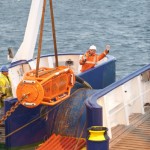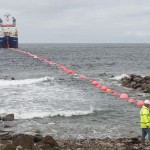Press release: Study on subsea cable lifecycle published
The European Marine Energy Centre (EMEC) and The Crown Estate have published a report on the performance of subsea cabling in high energy environments to support the development of commercial wave and tidal energy sites.
The key aim of the Subsea Cable Lifecycle Study is to improve the industry’s understanding of how best to specify and manage subsea cables for wave and tidal energy projects, by investigating how the cables installed at the EMEC test sites in Orkney have been performing since installation.
The report, available to download from The Crown Estate’s website, provides a summary of the review to inform the marine renewable energy industry on factors affecting the integrity and performance of subsea cables.
With its first cables installed over 10 years ago, EMEC has collected considerable amounts of data with numerous routine remotely operated vehicle (ROV) and inshore dive surveys undertaken to examine structural integrity, alongside comprehensive electrical cable testing.
During the study, this data was reviewed in relation to installation methods, faults, and operational life of the cables.
The study found that the subsea cables installed at the EMEC test sites appear to be in extremely good condition considering the environment in which they are deployed.
Matthew Finn, Senior Business Development Manager explains:
“EMEC has built up a colossal amount of data since we set up the test centre 12 years ago. As well as supporting our own operations, and those of our developer clients, we’re delighted to see our data put to use across other projects that will support the development of the nascent marine renewables industry.
“The strong tidal conditions at our tidal test site – up to 8 knots at peak tide – provide a unique opportunity for people looking to test components, equipment, devices and supporting infrastructure in real sea conditions. We want our infrastructure to be put to good use, and would like to see the cables utilised in supporting other technology testing and demonstration projects in the future as well.”
The report concludes that in sites with high tidal flow the greatest risk to subsea cables is the effect of cable strumming – vibration caused by the flow of water past the cable.
Key recommendations to developers of wave and tidal energy projects include: carrying out calculations to assess the risk of strumming at an early stage; completing detailed site surveys and optimising the cable route to avoid key risks; and protecting the cables with armouring in high energy environments.
Related press release: EMEC to study integrity of subsea cabling
*Update | October 2018*
Due to the document being removed from The Crown Estate website, the Subsea Cable Lifecycle report can be downloaded here:














